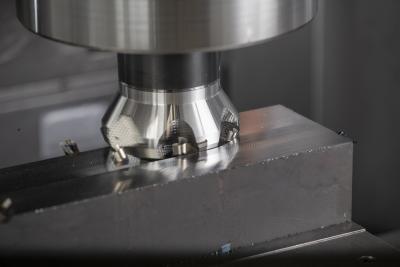
Shops with lower horsepower machines can maximize their facemilling operations with the new Seco Tools Double Quattromill14 facemilling cutter. For cost effectiveness and increased depths of cut in roughing, semifinishing and finishing, the cutter uses double-sided inserts with eight cutting edges and represents a smaller version of the company's Double Quattromill 22 cutter, which targets those machines with higher horsepower and torque.
The Double Quattromill 14 achieve depths of cut up to 0.236" (6mm) in its 45° lead angle version and up to 0.315" (8mm) in its 68° version. For better chip thinning and higher feed rates, the 45° angle excels in weak or unstable fixturing. With better clearance to avoid sidewalls or part fixturing than the 45° degree angle, the 68° angle reaches high depths of cut with the same size inscribed circle (IC) on the insert. The Double Quattromill 14 extends tool life while it lowers cutting forces and machine power consumption with its extremely free cutting qualities.
Available in standard or close pitch and in metric or inch versions, Double Quattromill 14 cutter bodies come in fixed-pocket and cassette styles. For enhanced chip control and evacuation as well as durability, Seco applied its new surface texture technology to the cutter's body flute surfaces.
To provide flexible options, the Double Quattromill 14 comes in three insert ranges with various edges and grades. The ME10 geometry works with sticky materials such as titanium and stainless steel. The M10 geometry includes sharper edges and smaller T lands for reduced cutting force that excels at lower horsepower levels, working with sticky materials, some tool steels and super alloys. The M16 provides the best edge protection of the three insert geometries when machining abrasive materials such as steels, tool steels and cast irons.
Contact Details
Related Glossary Terms
- abrasive
abrasive
Substance used for grinding, honing, lapping, superfinishing and polishing. Examples include garnet, emery, corundum, silicon carbide, cubic boron nitride and diamond in various grit sizes.
- alloys
alloys
Substances having metallic properties and being composed of two or more chemical elements of which at least one is a metal.
- cast irons
cast irons
Cast ferrous alloys containing carbon in excess of solubility in austenite that exists in the alloy at the eutectic temperature. Cast irons include gray cast iron, white cast iron, malleable cast iron and ductile, or nodular, cast iron. The word “cast” is often left out.
- clearance
clearance
Space provided behind a tool’s land or relief to prevent rubbing and subsequent premature deterioration of the tool. See land; relief.
- cutting force
cutting force
Engagement of a tool’s cutting edge with a workpiece generates a cutting force. Such a cutting force combines tangential, feed and radial forces, which can be measured by a dynamometer. Of the three cutting force components, tangential force is the greatest. Tangential force generates torque and accounts for more than 95 percent of the machining power. See dynamometer.
- facemilling
facemilling
Form of milling that produces a flat surface generally at right angles to the rotating axis of a cutter having teeth or inserts both on its periphery and on its end face.
- feed
feed
Rate of change of position of the tool as a whole, relative to the workpiece while cutting.
- inscribed circle ( IC)
inscribed circle ( IC)
Imaginary circle that touches all sides of an insert. Used to establish size. Measurements are in fractions of an inch and describe the diameter of the circle.
- lead angle
lead angle
Angle between the side-cutting edge and the projected side of the tool shank or holder, which leads the cutting tool into the workpiece.
- pitch
pitch
1. On a saw blade, the number of teeth per inch. 2. In threading, the number of threads per inch.
- surface texture
surface texture
Repetitive or random deviations from the nominal surface, which form 3-D topography of the surface. See flows; lay; roughness; waviness.
- tool steels
tool steels
Group of alloy steels which, after proper heat treatment, provide the combination of properties required for cutting tool and die applications. The American Iron and Steel Institute divides tool steels into six major categories: water hardening, shock resisting, cold work, hot work, special purpose and high speed.

